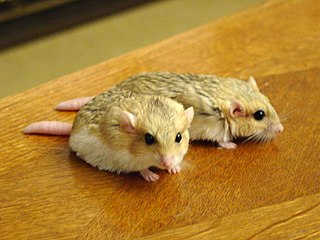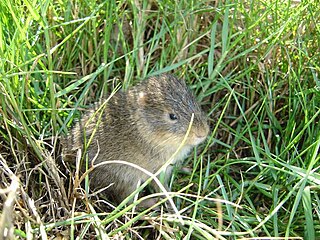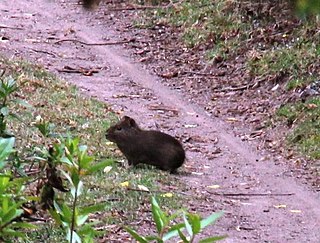
The guinea pig or domestic guinea pig, also known as the cavy or domestic cavy, is a species of rodent belonging to the genus Cavia in the family Caviidae. Breeders tend to use the name "cavy" for the animal, but "guinea pig" is more commonly used in scientific and laboratory contexts. Despite their name, guinea pigs are not native to Guinea, nor are they closely related to pigs. They originated in the Andes region of South America. Studies based on biochemistry and hybridization suggest they are domesticated animals that do not exist naturally in the wild, descendants of a closely related cavy species such as C. tschudii. They were originally domesticated as livestock for a source of meat, and are still consumed in some parts of the world.

Caviidae, the cavy family, is composed of rodents native to South America and includes the domestic guinea pig, wild cavies, and the largest living rodent, the capybara. They are found across South America in open areas from moist savanna to thorn forests or scrub desert. This family of rodents has fewer members than most other rodent families, with 19 species in 6 genera in 3 subfamilies.

The fat-tailed gerbil, also called the duprasi gerbil or doop, is a rodent belonging to the subfamily Gerbillinae. It is only species in the genus Pachyuromys. They are frequently kept as pets.

The term Hystricomorpha has had many definitions throughout its history. In the broadest sense, it refers to any rodent with a hystricomorphous zygomasseteric system. This includes the Hystricognathi, Ctenodactylidae, Anomaluridae, and Pedetidae. Molecular and morphological results suggest the inclusion of the Anomaluridae and Pedetidae in Hystricomorpha may be suspect. Based on Carleton & Musser 2005, these two families are discussed here as representing a distinct suborder Anomaluromorpha.

Caviinae is a subfamily uniting all living members of the family Caviidae with the exception of the maras, capybaras, and Kerodon. The subfamily traditionally contained the guinea pig or cavy-like forms along with the cursorially adapted (running) Kerodon. Molecular results suggest the Caviinae as so defined would be paraphyletic and Kerodon is more closely related to maras and capybaras than to other caviines. This led Woods and Kilpatrick (2005) to unite Kerodon and capybaras into the subfamily Hydrochoerinae within the Caviidae. These studies also suggest Microcavia and Cavia are more closely related to one another than either is to Galea.

Cavia is a genus in the subfamily Caviinae that contains the rodents commonly known as guinea pigs or cavies. The best-known species in this genus is the domestic guinea pig, Cavia porcellus, a meat animal in South America and a common household pet outside of that continent.

The Brazilian guinea pig is a guinea pig species found in Argentina, Brazil, Bolivia, Colombia, Ecuador, Guyana, Paraguay, Uruguay and Venezuela.

Santa Catarina's guinea pig or Moleques do Sul cavy is a rare guinea pig species of southeastern South America.

The greater guinea pig is a species of rodent found in the coastal strip of Brazil and Uruguay, where it lives in moist grassland and marshes.

The montane guinea pig is a species of caviid rodent found in the Andes in South America. The montane guinea pig is the likely main ancestor of Cavia porcellus, the domestic guinea pig or domestic cavy, which appears to be a hybrid that includes lesser genetic contributions from other Cavia species.
Cavia anolaimae is a guinea pig species from South America. It is found in Colombia near Bogotá. It is believed to be a feral offshoot of the domestic guinea pig, Cavia porcellus, and is often treated as a synonym of C. porcellus, but Zúñiga et al. (2002), based on morphologic characters, recognized them as different species. According to the molecular analysis of Dunnum and Salazar (2010) C. anolaimae is a subspecies of Cavia aperea, C. aperea anolaimae, and a possible synonymous of C. a. guianae.

Cavia guianae is a guinea pig species from South America. It is found in southern Venezuela, Guyana, and portions of northern Brazil. Some biologists believe it to be a feral offshoot of the domestic guinea pig, Cavia porcellus; others subsume it under the wild cavy, Cavia aperea. Molecular data collected show there is little genetic differentiation in C.a. guianae known to be a lowland locality in comparison to C. anolaimae which are predominantly highland populations.
The Guaira spiny-rat is a species of rodent in the family Echimyidae. It is endemic to Venezuela. It is commonly referred to as 'casiragua' to avoid confusion with true rats (Muroidea)

Rodents are mammals of the order Rodentia, which are characterized by a single pair of continuously growing incisors in each of the upper and lower jaws. About 40% of all mammal species are rodents. They are native to all major land masses except for New Zealand, Antarctica, and several oceanic islands, though they have subsequently been introduced to most of these land masses by human activity.

The Muenster yellow-toothed cavy is a species of rodent in the family Caviidae. It is known only from one location in Valle Hermoso in the Bolivian Andes, at an elevation of 2,557 m (8,389 ft). Specimens from this location were shipped to Muenster, Germany, in 1997 for laboratory research, where the species was recognized and described. Galea monasteriensis was recognized on the basis of morphological, behavioral, and reproductive differences from related species. However, its habits in the wild have not been studied.

Galea is a genus of South American rodents of the family Caviidae. 5-6 extant species are known, found in Argentina, Bolivia, Chile, Peru and Brazil. They are:

Alfred Nehring was a German zoologist and paleontologist.
Dr. Barbara J. Weir was a scientist, adventurer, and editor from the United Kingdom. Her discovery and extensive study of estrus in Galea musteloides illuminated the workings of some rodents' reproductive systems. Barbara Weir is most recognized for her comparative study on the breeding habits of Cavia aperea, and two related species, Galea musteloides, and Microcavia australis. Weir was also an editor for the Journal of Reproduction and Fertility from 1976 to 1990 where she was recognized for her "firm and fair role" as editor.













